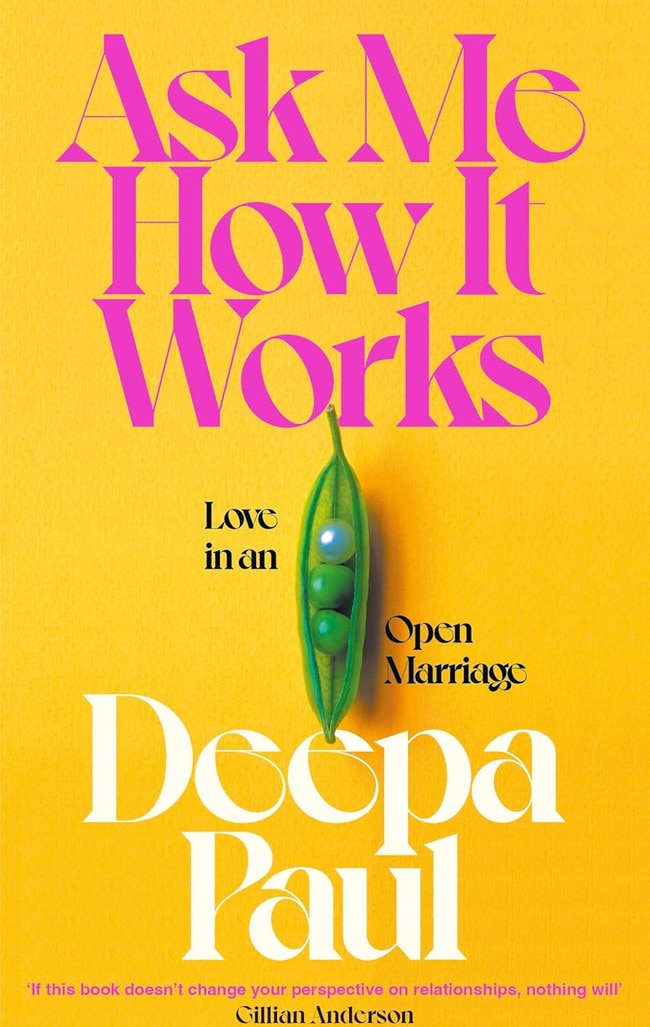How love works in an open marriage
Do you still have sex with your husband? These and other impertinent questions are asked and answered in a new memoir by a woman in an open marriage.

You know the old joke: How do you know if someone went to Europe? Don’t worry, they’ll tell you. These days the joke works better if you send up polyamorists instead. People in non-monogamous marriages, in which spouses openly have lovers, a boyfriend or a girlfriend (or more), seemingly really like to talk about it, and in recent years publishers have gobbled up these more-is-more tales.

Among the glut, More: A Memoir of Open Marriage, by Molly Roden Winter was the standout marmalade-dropper last year. Now Deepa Paul, a Filipino-Indian author based in Amsterdam, has written what will surely be this year’s standout bed-hopping, open-marriage memoir, Ask Me How It Works. It triggered a six-way bidding war among the top UK publishers and no doubt next year there will be another tell-all to wrestle over.
Sparing zero blushes, her debut book is not for the pearl-clutching brigade. It is a gloriously unapologetic raunch-fest that makes 50 Shades of Grey look like Georgette Heyer. There are “nipple orgasms”, endless role play and a sex party on Zoom (it was Covid) – and those are just the bits that are safe to mention in a family newspaper. However, it is also a meditation on self-identity, the loneliness of early motherhood and fulfilment and communication in a long-term relationship.
In her early 30s, Paul, a freelance copywriter, relocated from Singapore to Amsterdam with her corporate rule-following husband, Marcus. Not long afterwards, as a new mother with a two-month-old daughter, she joined him on a business trip to Berlin. In a few snatched hours alone she ended up cheating on Marcus with Thomas, who had placed an advert on Craigslist (“very handsome man looking for big belly”). She met Thomas again in Vienna … cue getting caught, marriage therapy sessions, the joint decision to experiment with an open marriage and separately setting up profiles on a dating app.
“Shedding the invisibility cloak of marriage and motherhood, I became a magnet for men I thought would never give me a second look,” Paul writes. The lovers, misadventures and escapades are full-throttle with a vibrant cast of characters.
She dates a mischievous hotel concierge who sneaks them into the best suites, a tattooed accountant “with a taste for bourbon and bondage”, and a cook at a trendy brunch spot who “dished out eggs benedict in the morning and bent me over the tables at night”. There’s the submissive financier who paints Paul’s nails while dressed as a French maid (“I had to wonder if he wanted to do me or be me”) and the Sicilian produce importer who was a runner for the mafia in his youth. “I came for the sex and stayed for the stories. Tall tales were my pillow talk,” Paul writes.

Meanwhile, Marcus throws himself into the Japanese art of shibari – rope bondage – and on one successful date night he ends up with three women in one hotel bed.
Besides all the sex, there is a lot of talking about the setting of rules, discussions of boundaries, confessions of feelings and worries of someone new stealing your spouse. Paul expertly breaks down the “emotional housekeeping” involved when parents bring other people into their marriage. This is not a book for those allergic to therapy-speak.
The chapters are headlined with the go-to questions that monogamous people in general and men on dating apps ask her: What are the rules? Are you ever jealous? Do you still have sex with your husband? And so on. Paul lays it all bare.
The couple’s early rules included: let me know about your dates in advance, no romancing colleagues, no dates at home and no sleeping over. Yes, Paul still has sex with her husband and when either of them gets jealous they delve into the details. “Emphatic listening” is a central theme. I could have read more about the reactions of her family in The Philippines, a Catholic country where divorce is illegal, when she comes out to them as non-monogamous.
Careering around the streets of Amsterdam on her bicycle seeking thrills, Paul also discovers techno raves and Ecstasy. The assured, energetic narrative pulls you into her hedonistic, pleasure-is-paramount bubble. And it helps that she’s funny: “Cheese and tulips were nice but these were the adventures we’d come to Europe for!” But inevitably, when the subjects are sex and raving, there are a few cringe-worthy lines. When she and Marcus are clubbing, for example, “people gravitate towards us for the energy we generate”.
Thankfully, Paul doesn’t get bogged down by the polyamory lingo. There are only the briefest of mentions of “new relationship energy”, which refers to the excitement felt at the beginning of a romantic or sexual relationship, and “compersion”, which is feeling happy for your partner finding romantic pleasure elsewhere.
There is no meditation on whether polyamory is having a moment in Western societies or why, culturally, some people have become hooked by “poly”.
The adventuring develops as the years go on. Her rules loosen and her goal becomes genuine connections rather than just fun. Enter stage left an Irish photographer with expressive eyebrows and an open mind. The action ends with Paul in her early 40s happy with her husband of 17 years and also happy with her Irish boyfriend of almost five years, and with the author’s 11-year-old daughter knowing her parents love each other and have “sleepovers” with other people.





To join the conversation, please log in. Don't have an account? Register
Join the conversation, you are commenting as Logout